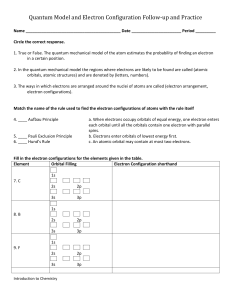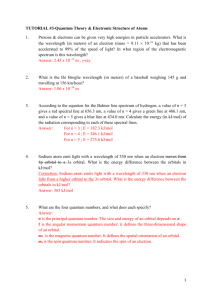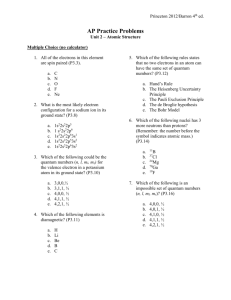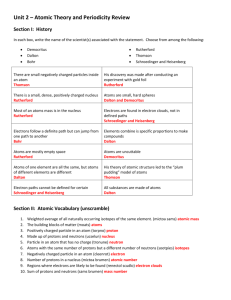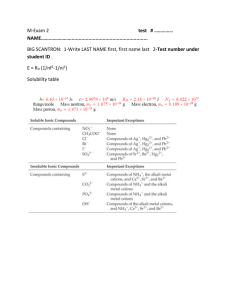electronconfiguratiobrittanyf
advertisement
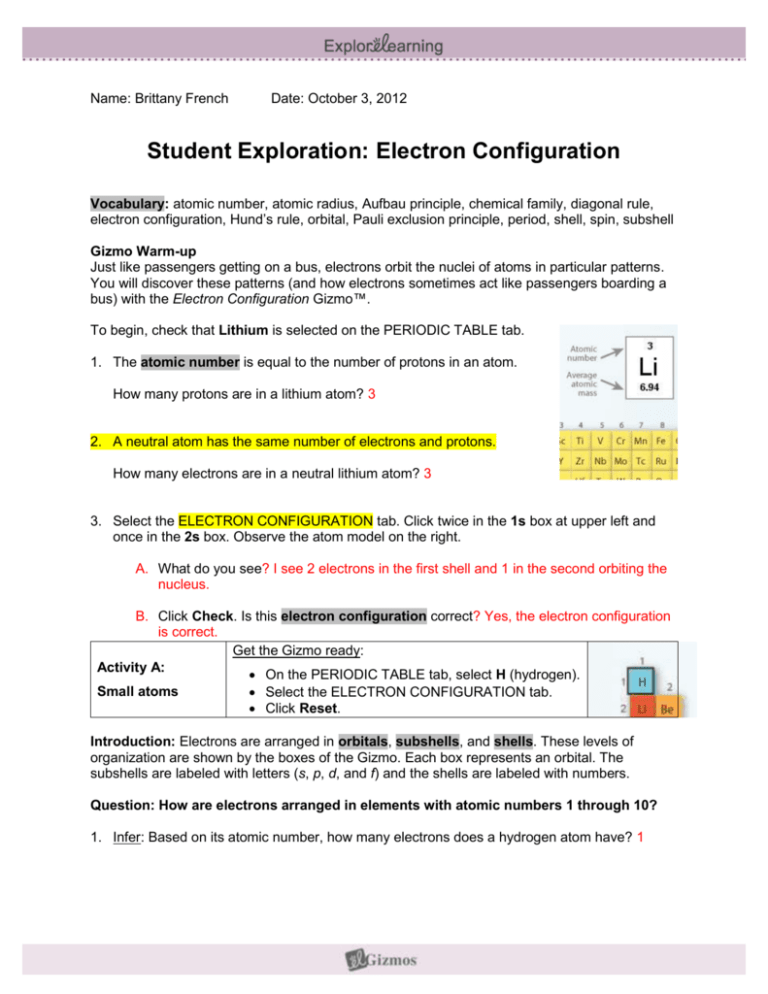
Name: Brittany French Date: October 3, 2012 Student Exploration: Electron Configuration Vocabulary: atomic number, atomic radius, Aufbau principle, chemical family, diagonal rule, electron configuration, Hund’s rule, orbital, Pauli exclusion principle, period, shell, spin, subshell Gizmo Warm-up Just like passengers getting on a bus, electrons orbit the nuclei of atoms in particular patterns. You will discover these patterns (and how electrons sometimes act like passengers boarding a bus) with the Electron Configuration Gizmo™. To begin, check that Lithium is selected on the PERIODIC TABLE tab. 1. The atomic number is equal to the number of protons in an atom. How many protons are in a lithium atom? 3 2. A neutral atom has the same number of electrons and protons. How many electrons are in a neutral lithium atom? 3 3. Select the ELECTRON CONFIGURATION tab. Click twice in the 1s box at upper left and once in the 2s box. Observe the atom model on the right. A. What do you see? I see 2 electrons in the first shell and 1 in the second orbiting the nucleus. B. Click Check. Is this electron configuration correct? Yes, the electron configuration is correct. Get the Gizmo ready: Activity A: On the PERIODIC TABLE tab, select H (hydrogen). Small atoms Select the ELECTRON CONFIGURATION tab. Click Reset. Introduction: Electrons are arranged in orbitals, subshells, and shells. These levels of organization are shown by the boxes of the Gizmo. Each box represents an orbital. The subshells are labeled with letters (s, p, d, and f) and the shells are labeled with numbers. Question: How are electrons arranged in elements with atomic numbers 1 through 10? 1. Infer: Based on its atomic number, how many electrons does a hydrogen atom have? 1 2. Arrange: The Aufbau principle states that electrons occupy the lowest-energy orbital. Click once in the 1s box to add an electron to the only orbital in the s subshell of the first shell. Click Check. What is the electron configuration of hydrogen? 1s1 3. Arrange: Click Next element to select helium. Add another electron to the 1s orbital. The arrows represent the spin of the electron. What do you notice about the arrows? The first arrow points up the second points down The Pauli exclusion principle states that electrons sharing an orbital have opposite spins. 4. Check your work: Click Check. What is the electron configuration of helium? 1s2 5. Arrange: Click Next element and create electron configurations for lithium, beryllium, and boron. Click Check to check your work, and then list each configuration below: Lithium: 1s2 2s1 Beryllium: 1s2 2s2 Boron: 1s2 2s2 2p1 6. Arrange: Click Next element to select carbon. Add a second electron to the first 2p orbital. Click Check. What feedback is given? Electrons not properly arranged in energy levels 7. Rearrange: Hund’s rule states that electrons will occupy an empty orbital when it is available in that subshell. Rearrange the electrons within the 2p subshell and click Check. Is the configuration correct now? Yes 1s Show the correct configuration in the boxes at right: 2s 2p DRAG AND DROP THE CORRECT NUMBER OF ARROWS TO THE ORBITAL BOXES: Activity A 8. Compare: How are the electrons in the 2p subshell similar to passengers getting on a bus? They all go in their own seat till they’re all filled then, they share seats with one another. (Activity A continued on next page) 9. Practice: In the spaces below, write electron configurations for the next four elements: nitrogen, oxygen, fluorine, and neon. When you are finished, use the Gizmo to check your work. Correct any improper configurations. DRAG AND DROP THE CORRECT NUMBER OF ARROWS TO THE ORBITAL BOXES: 1s Nitrogen configuration: 1s2 2s2 2p3 2s 2p DRAG AND DROP THE CORRECT NUMBER OF ARROWS TO THE ORBITAL BOXES: 1s Oxygen configuration: 1s2 2s2 2p4 2s 2p DRAG AND DROP THE CORRECT NUMBER OF ARROWS TO THE ORBITAL BOXES: 1s Fluorine configuration: 1s2 2s2 2p5 2s 2p DRAG AND DROP THE CORRECT NUMBER OF ARROWS TO THE ORBITAL BOXES: 1s Neon configuration: 1s2 2s2 2p6 2s 2p 10. Apply: Atoms are most stable when their outermost shell is full. If their outermost shell is not full, atoms tend to gain, lose, or share electrons until the shell fills up. While doing this, atoms react and form chemical bonds with other atoms. Based on this, what can you infer about the reactivity of helium and neon? Neon will not have much of a reaction then what Helium will have. Because Neon has full shells. Look at that statement from above if they have full shells would they react? Good, note that both of them have full shells though. 11. Think and discuss: Select the PERIODIC TABLE tab, and look at the second row, or period, of the table. How does this row reflect the subshells of the second shell? There’s only 8 elements in the row and the energy level can only hold 8 electrons. 12. Think and discuss: Compare the electron configurations of hydrogen, lithium, and sodium. Why do you think these elements are grouped in the same family? Because they are alkall metals. Get the Gizmo ready: Activity B : The diagonal rule 12. On the PERIODIC TABLE tab, select Ar (argon). 13. Select the ELECTRON CONFIGURATION tab. 14. Turn on Show number of electrons. Introduction: Beyond argon, it is a bit tricky to determine which subshell gets filled next. There are several rules that scientists use to determine the electron configurations of larger atoms. Question: How are the electron configurations of elements beyond argon determined? 1. Arrange: Create the correct electron configuration for argon. Then, click Next element to get to potassium (K). Click once in the first 3d orbital, and then click Check. What feedback is given? Electrons are not placed correctly in energy levels. 2. Rearrange: As it happens, the 4s subshell is a lower-energy subshell than 3d, so it is filled first. Remove the electron from the 3d orbital and place it in the 4s orbital. Click Check. (Note: For simplicity, all but the outer shell electrons will disappear on the Bohr Model.) Is this configuration correct? Yes 4s1 What is the configuration? 1s2 2s2 2p6 3s2 3p6 3. Arrange: Click Next element and add an electron for calcium. Click Check. What is the electron configuration for calcium? 1s2 2s2 2p6 3s2 3p6 4s2 4. Arrange: Click Next element and add an electron for scandium. Try different orbitals until you find the right one. What is the electron configuration for scandium? 1s2 2s2 2p6 3s2 3p6 3d1 4s2 5. Observe: Scandium is the first element to contain electrons in the d subshell. How many orbitals does the d subshell have, and how many electrons can fit in the d subshell? D shell can have 4 orbitals and 10 electrons. Recheck this. The number of orbitals is how many boxes D has. Then, how many electrons will fit in those boxes? Recheck this number. How many boxes are in the D orbital? I think this is right, but I’m not quite sure! 6. Infer: Select the PERIODIC TABLE tab. The middle section of the table is a chemical family called the transition metals. Why do you think this section is ten columns wide? Because, it the energy level can only hold 10 electrons. use that for the question above 7. Make a rule: The diagonal rule explains which subshell will be filled next. To follow the diagonal rule, move down along an arrow until you reach the end of the arrow. Then move to the start of the next arrow to the right. Sorry, I didn’t pay close attention! A. Which subshell is filled after 4p? 5s B. Which subshell is filled after 6s? 5d C. Which subshell is filled after 5d? 6s You should follow the arrows down and to the left to get the next energy level. 8. Practice: Determine the electron configurations of the following elements. Use the Gizmo to check your work. (Note: In some cases, the diagonal rule doesn’t work perfectly. If you submit a theoretically correct configuration, the Gizmo will give you the actual configuration.) Element Atomic number Electron configuration Cobalt (Co) 27 1s2 2s2 2p6 3s2 3p6 3d7 4s2 Bromine (Br) 35 1s2 2s2 2p6 3s2 3p6 3d10 4s2 4p5 Magnesium (Mg) 12 1s2 2s2 2p6 3s2 Strontium (Sr) 38 1s2 2s2 2p6 3p6 3d10 4s2 4p6 5s2 Aluminum (Al) 13 1s2 2s2 2p6 3s2 3p1 9. Infer: Select the PERIODIC TABLE tab. A. Which subshell is represented by the alkali and alkaline metal families? S Subshell B. Which subshell is represented by the transition metals? D Subshell C. Groups 13 – 18 represent which subshell? P Subshell D. In general, how is the shape of the periodic table related to electron configurations? (If necessary, continue your answer on another sheet of paper.) It’s related because, it goes from the S orbitals to the other orbitals showing there electrons and energy source.
